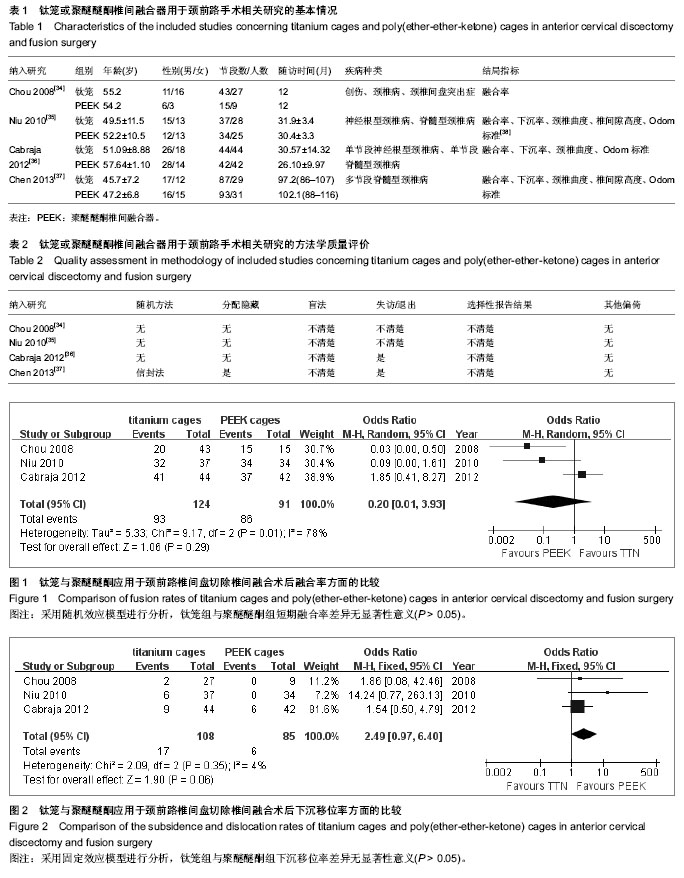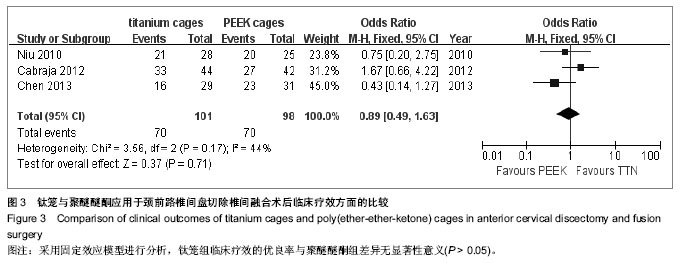| [1] Cloward RB.The anterior approach for removal of ruptured cervical disks.J Neurosurg. 1958;15(6):602-617.[2] Smith GW, Robinson RA.The treatment of certain cervical-spine disorders by anterior removal of the intervertebral disc and interbody fusion.J Bone Joint Surg Am. 1958;40-A(3):607-624.[3] Zdeblick TA, Ducker TB.The use of freeze-dried allograft bone for anterior cervical fusions.Spine (Phila Pa 1976). 1991;16(7): 726-729.[4] Young WF, Rosenwasser RH. An early comparative analysis of the use of fibular allograft versus autologous iliac crest graft for interbody fusion after anterior cervical discectomy.Spine (Phila Pa 1976). 1993;18(9):1123-1124.[5] Baba H, Furusawa N, Tanaka Y,et al.Anterior decompression and fusion for cervical myeloradiculopathy secondary to ossification of the posterior ligament.Int Orthop. 1994;18(4): 204-209.[6] An HS, Simpson JM, Glover JM,et al.Comparison between allograft plus demineralized bone matrix versus autograft in anterior cervical fusion. A prospective multicenter study.Spine (Phila Pa 1976). 1995;20(20):2211-2216.[7] Malloy KM, Hilibrand AS.Autograft versus allograft in degenerative cervical disease.Clin Orthop Relat Res. 2002; (394):27-38.[8] Truumees E, Demetropoulos CK, Yang KH,et al. Effects of disc height and distractive forces on graft compression in an anterior cervical discectomy model.Spine (Phila Pa 1976). 2002;27(22):2441-2445.[9] Kaiser MG, Haid RW Jr, Subach BR,et al.Anterior cervical plating enhances arthrodesis after discectomy and fusion with cortical allograft.Neurosurgery. 2002;50(2):229-36.[10] Thomé C, Krauss JK, Zevgaridis D.A prospective clinical comparison of rectangular titanium cages and iliac crest autografts in anterior cervical discectomy and fusion. Neurosurg Rev. 2004;27(1):34-41. [11] Jagannathan J, Shaffrey CI, Oskouian RJ,et al.Radiographic and clinical outcomes following single-level anterior cervical discectomy and allograft fusion without plate placement or cervical collar.J Neurosurg Spine. 2008;8(5):420-428.[12] Francke EI, Demetropoulos CK, Agabegi SS,et al.Distractive force relative to initial graft compression in an in vivo anterior cervical discectomy and fusion model.Spine (Phila Pa 1976). 2010;35(5):526-530.[13] Younger EM, Chapman MW.Morbidity at bone graft donor sites.J Orthop Trauma. 1989;3(3):192-195.[14] Zdeblick TA, Phillips FM.Interbody cage devices.Spine (Phila Pa 1976). 2003;28(15 Suppl):S2-7.[15] Schmieder K, Wolzik-Grossmann M, Pechlivanis I,et al. Subsidence of the wing titanium cage after anterior cervical interbody fusion: 2-year follow-up study.J Neurosurg Spine. 2006;4(6):447-453.[16] Arrington ED, Smith WJ, Chambers HG,et al.Complications of iliac crest bone graft harvesting.Clin Orthop Relat Res. 1996; (329):300-309.[17] Goulet JA, Senunas LE, DeSilva GL,et al.Autogenous iliac crest bone graft. Complications and functional assessment.Clin Orthop Relat Res. 1997;(339):76-81.[18] Brooke NS, Rorke AW, King AT,et al.Preliminary experience of carbon fibre cage prostheses for treatment of cervical spine disorders.Br J Neurosurg. 1997;11(3):221-227.[19] Cho DY, Liau WR, Lee WY,et al.Preliminary experience using a polyetheretherketone (PEEK) cage in the treatment of cervical disc disease.Neurosurgery. 2002;51(6):1343-1349.[20] Wang X, Chen Y, Chen D,et al.Anterior decompression and interbody fusion with BAK/C for cervical disc degenerative disorders.J Spinal Disord Tech. 2009;22(4):240-245. [21] Moreland DB, Asch HL, Clabeaux DE,et al.Anterior cervical discectomy and fusion with implantable titanium cage: initial impressions, patient outcomes and comparison to fusion with allograft.Spine J. 2004;4(2):184-191.[22] Matgé G.Cervical cage fusion with 5 different implants: 250 cases.Acta Neurochir (Wien). 2002;144(6):539-549.[23] Hwang SL, Lin CL, Lieu AS,et al.Three-level and four-level anterior cervical discectomies and titanium cage-augmented fusion with and without plate fixation.J Neurosurg Spine. 2004;1(2):160-167.[24] van Jonbergen HP, Spruit M, Anderson PG,et al. Anterior cervical interbody fusion with a titanium box cage: early radiological assessment of fusion and subsidence.Spine J. 2005;5(6):645-649.[25] Kao FC, Niu CC, Chen LH,et al.Maintenance of interbody space in one- and two-level anterior cervical interbody fusion: comparison of the effectiveness of autograft, allograft, and cage.Clin Orthop Relat Res. 2005;(430):108-116.[26] Hwang SL, Hwang YF, Lieu AS,et al.Outcome analyses of interbody titanium cage fusion used in the anterior discectomy for cervical degenerative disc disease.J Spinal Disord Tech. 2005;18(4):326-331.[27] Katzer A, Marquardt H, Westendorf J,et al. Polyetheretherketone- cytotoxicity and mutagenicity in vitro.Biomaterials. 2002;23(8):1749-1759.[28] Toth JM, Wang M, Estes BT,et al.Polyetheretherketone as a biomaterial for spinal applications.Biomaterials. 2006;27(3): 324-334.[29] Boakye M, Mummaneni PV, Garrett M,et al.Anterior cervical discectomy and fusion involving a polyetheretherketone spacer and bone morphogenetic protein.J Neurosurg Spine. 2005;2(5):521-525.[30] Dorai Z, Morgan H, Coimbra C.Titanium cage reconstruction after cervical corpectomy.J Neurosurg. 2003;99(1 Suppl):3-7.[31] Cutler AR, Siddiqui S, Mohan AL,et al.Comparison of polyetheretherketone cages with femoral cortical bone allograft as a single-piece interbody spacer in transforaminal lumbar interbody fusion.J Neurosurg Spine. 2006;5(6): 534-539.[32] Chiang CJ, Kuo YJ, Chiang YF,et al.Anterior cervical fusion using a polyetheretherketone cage containing a bovine xenograftp: three to five-year follow-up.Spine (Phila Pa 1976). 2008;33(23):2524-2528. [33] Lemcke J, Al-Zain F, Meier U, et al. Polyetheretherketone (PEEK) Spacers for Anterior Cervical Fusion: A Retrospective Comparative Effectiveness Clinical Trial.Open Orthop J. 2011; 5:348-353.[34] Chou YC, Chen DC, Hsieh WA,et al.Efficacy of anterior cervical fusion: comparison of titanium cages, polyetheretherketone (PEEK) cages and autogenous bone grafts.J Clin Neurosci. 2008;15(11):1240-1245.[35] Niu CC, Liao JC, Chen WJ,et al.Outcomes of interbody fusion cages used in 1 and 2-levels anterior cervical discectomy and fusion: titanium cages versus polyetheretherketone (PEEK) cages.J Spinal Disord Tech. 2010;23(5):310-316.[36] Cabraja M, Oezdemir S, Koeppen D,et al.Anterior cervical discectomy and fusion: comparison of titanium and polyetheretherketone cages.BMC Musculoskelet Disord. 2012; 13:172. [37] Chen Y, Wang X, Lu X,et al.Comparison of titanium and polyetheretherketone (PEEK) cages in the surgical treatment of multilevel cervical spondylotic myelopathy: a prospective, randomized, control study with over 7-year follow-up.Eur Spine J. 2013;22(7):1539-1546. [38] Odom GL, Finney W, Woodhall B.Cervical disk lesions.J Am Med Assoc. 1958;166(1):23-28.[39] Barsa P, Suchomel P.Factors affecting sagittal malalignment due to cage subsidence in standalone cage assisted anterior cervical fusion.Eur Spine J. 2007;16(9):1395-1400.[40] Wilke HJ, Kettler A, Goetz C,et al.Subsidence resulting from simulated postoperative neck movements: an in vitro investigation with a new cervical fusion cage.Spine (Phila Pa 1976). 2000;25(21):2762-2770.[41] Gercek E, Arlet V, Delisle J,et al.Subsidence of stand-alone cervical cages in anterior interbody fusion: warning.Eur Spine J. 2003;12(5):513-516. [42] Hacker RJ.A randomized prospective study of an anterior cervical interbody fusion device with a minimum of 2 years of follow-up results.J Neurosurg. 2000;93(2 Suppl):222-226.[43] Profeta G, de Falco R, Ianniciello G,et al.Preliminary experience with anterior cervical microdiscectomy and interbody titanium cage fusion (Novus CT-Ti) in patients with cervical disc disease.Surg Neurol. 2000;53(5):417-426.[44] Bärlocher CB, Barth A, Krauss JK,et al.Comparative evaluation of microdiscectomy only, autograft fusion, polymethylmethacrylate interposition, and threaded titanium cage fusion for treatment of single-level cervical disc disease: a prospective randomized study in 125 patients.Neurosurg Focus. 2002;12(1):E4.[45] Toth JM, Wang M, Estes BT,et al.Polyetheretherketone as a biomaterial for spinal applications.Biomaterials. 2006;27(3): 324-334. [46] Mastronardi L, Ducati A, Ferrante L.Anterior cervical fusion with polyetheretherketone (PEEK) cages in the treatment of degenerative disc disease. Preliminary observations in 36 consecutive cases with a minimum 12-month follow-up.Acta Neurochir (Wien). 2006;148(3):307-312.[47] Vadapalli S, Sairyo K, Goel VK,et al.Biomechanical rationale for using polyetheretherketone (PEEK) spacers for lumbar interbody fusion-A finite element study.Spine (Phila Pa 1976). 2006;31(26):E992-998.[48] Yang JJ, Yu CH, Chang BS,et al.Subsidence and nonunion after anterior cervical interbody fusion using a stand-alone polyetheretherketone (PEEK) cage.Clin Orthop Surg. 2011; 3(1):16-23.[49] Kulkarni AG, Hee HT, Wong HK.Solis cage (PEEK) for anterior cervical fusion: preliminary radiological results with emphasis on fusion and subsidence.Spine J. 2007;7(2): 205-209. [50] Dufour T, Huppert J, Louis C,et al.Radiological analysis of 37 segments in cervical spine implanted with a peek stand-alone device, with at least one year follow-up.Br J Neurosurg. 2010; 24(6):633-640. [51] Ha SK, Park JY, Kim SH,et al.Radiologic Assessment of Subsidence in Stand-Alone Cervical Polyetheretherketone (PEEK) Cage.J Korean Neurosurg Soc. 2008;44(6):370-374. [52] Kolstad F, Nygaard ØP, Andresen H,et al.Anterior cervical arthrodesis using a "stand alone" cylindrical titanium cage: prospective analysis of radiographic parameters.Spine (Phila Pa 1976). 2010;35(16):1545-1550.[53] Shousha M, Ezzati A, Boehm H.Four-level anterior cervical discectomies and cage-augmented fusion with and without fixation.Eur Spine J. 2012;21(12):2512-2519. [54] Song KJ, Yoon SJ, Lee KB.Three- and four-level anterior cervical discectomy and fusion with a PEEK cage and plate construct.Eur Spine J. 2012;21(12):2492-2497. |

